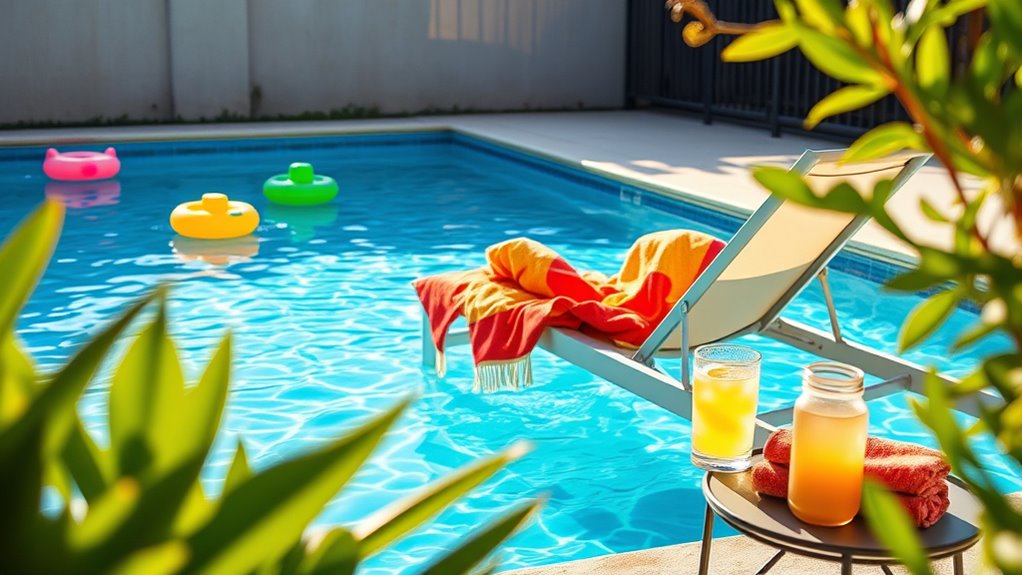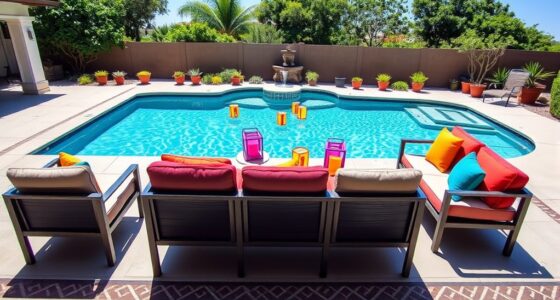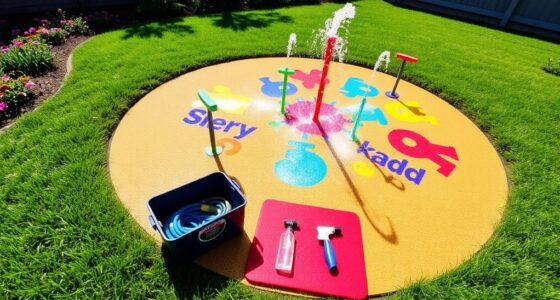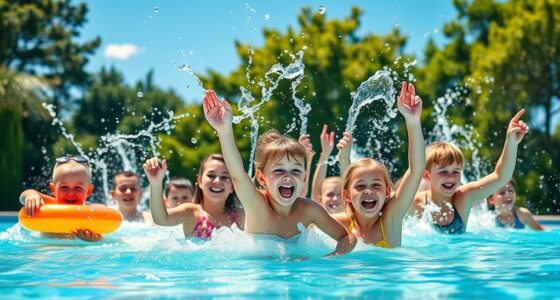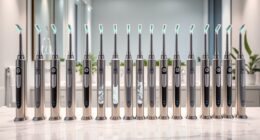After a pool party, start by testing your water’s pH, chlorine, and alkalinity levels to see where they stand. Perform a shock treatment at dusk to oxidize contaminants and help restore balance. Recheck your test results and make gradual adjustments to pH and alkalinity, then monitor chlorine levels over the next few days. Keep your filtration system running well and stay vigilant to keep your pool sparkling and safe—more tips await if you continue.
Key Takeaways
- Test water chemistry immediately after the event and regularly monitor pH, chlorine, and alkalinity levels.
- Adjust pH gradually with acid or soda ash, and balance alkalinity with sodium bicarbonate as needed.
- Perform a shock treatment to oxidize organic contaminants and reduce chloramine buildup.
- Ensure proper filtration and circulation, backwashing filters, and maintaining water levels for clarity.
- Continue daily testing and adjustments for 48 hours post-party to restore optimal water balance.
Assessing Water Chemistry Immediately After the Event
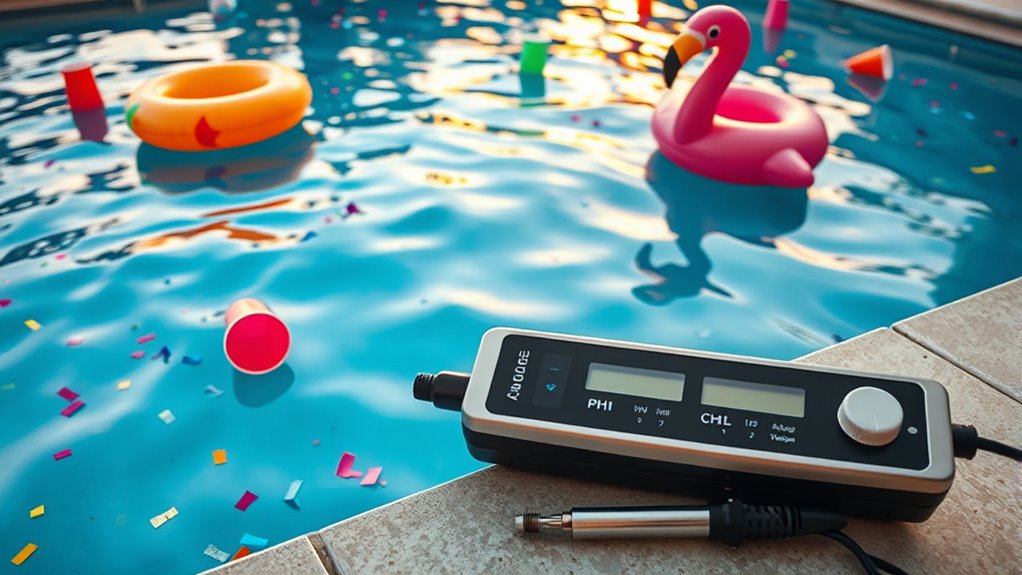
After a pool party, you should immediately test the water chemistry to guarantee it remains safe and clear. Check the free chlorine levels to ensure they stay between 1-3 ppm, providing effective germ-killing and clarity. Test the pH, aiming for a balanced 7.2–7.6 to prevent cloudiness and skin irritation. Measure total alkalinity, targeting 80–120 ppm, to stabilize pH and avoid fluctuations. Assess calcium hardness within 200–400 ppm to prevent corrosion or scaling. Lastly, evaluate cyanuric acid levels, ideally around 25–50 ppm, to protect chlorine from UV degradation without overdosing. These tests give you a clear picture of your water’s current state, helping you determine necessary adjustments and maintain a safe swimming environment. Accurate testing also allows you to identify potential issues early and prevent long-term water quality problems.
Performing Shock Treatment to Oxidize Contaminants
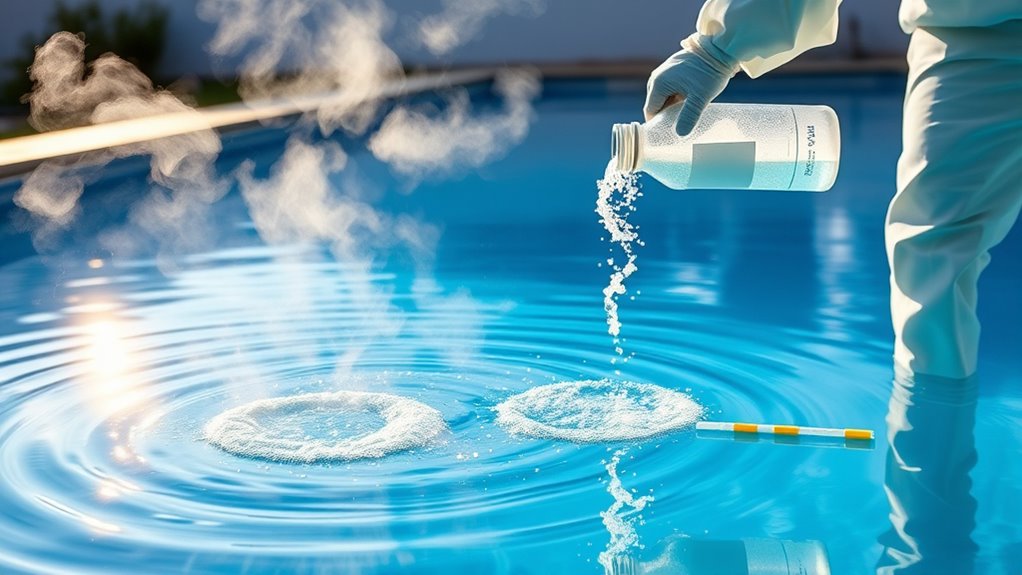
Performing shock treatment is essential for removing contaminants introduced during a pool party, such as sweat, oils, urine, and lotions. It oxidizes these substances, breaking down chloramines that cause skin and eye irritation and bad odors. Shock also eliminates bacteria and algae that guests may bring in, helping to keep your water clean and safe. There are different types of pool shock: chlorine-based, like calcium hypochlorite, and non-chlorine options, such as potassium monopersulfate. Follow manufacturer instructions carefully to choose the right one and dose correctly. For best results, apply shock at night or dusk, with the pump and filter running continuously. Brushing the pool walls helps distribute the shock evenly, ensuring maximum oxidation of contaminants. Proper application of shock treatment maximizes its effectiveness in restoring water clarity and safety.
Rechecking Ph, Chlorine, and Alkalinity Levels
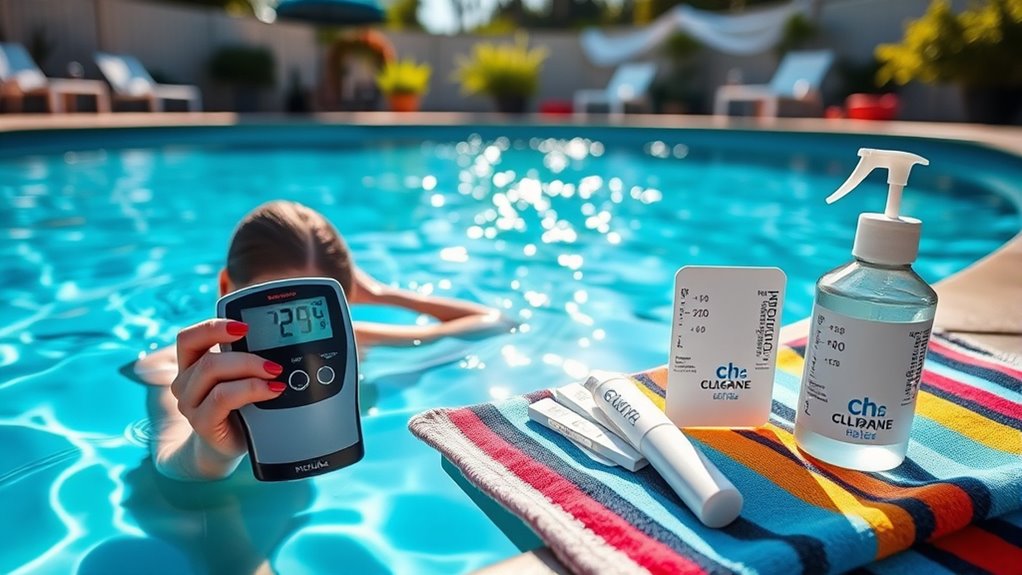
After a pool party, you should immediately test your pH, chlorine, and alkalinity levels to guarantee they’re within the ideal ranges. Regular rechecking every 4 to 6 hours helps keep your water balanced, especially after heavy use. Adjust levels carefully with the right chemicals to maintain a safe, comfortable swimming environment. Heavy bather load introduces contaminants that unbalance pool chemistry, so consistent monitoring is essential to ensure water quality. It is also helpful to remember that maintaining a healthy pool environment promotes ongoing water clarity and safety.
Testing Frequency Recommendations
Maintaining proper chemical balance requires modifying your testing frequency based on pool conditions and usage. After heavy swim sessions or pool parties, test pH and chlorine multiple times daily to catch rapid changes. During stable swim seasons, testing 2 to 3 times weekly suffices, with alkalinity checked at least once a week. Factors like heavy rain, high temperatures, or increased bather load demand more frequent testing to ensure water remains balanced. Use reliable test kits and sample from different locations to get accurate readings. Always retest after making adjustments within 24 hours to confirm stability. If imbalances persist, increase testing to daily until water is properly balanced. Proper monitoring helps prevent issues and keeps your pool safe and clear. Regular water chemistry testing is essential for early detection of imbalances and maintaining optimal water quality.
Target Chemical Ranges
To keep your pool water safe and comfortable, it’s essential to regularly check that your chemical levels stay within their target ranges. The ideal pH for swimming pools is between 7.4 and 7.6, ensuring effective chlorine and swimmer comfort. Acceptable pH levels are 7.2 to 7.8, but readings outside this range can cause problems like scaling or irritation. Maintain free chlorine between 2 and 3 ppm for proper sanitation, especially after heavy use. Levels below 1 ppm increase risks, while above 3 ppm may cause irritation. Alkalinity should be kept between 80 and 120 ppm to stabilize pH and prevent fluctuations. After a party, test these levels to identify any imbalances and prepare for necessary adjustments to keep your pool safe and inviting. Regular testing helps you maintain proper chemical balance and avoid potential issues.
Adjusting Levels Safely
Once you’ve tested your pool’s chemical levels following a party, it’s time to make safe adjustments. First, focus on pH, chlorine, and alkalinity, adjusting each carefully to maintain water balance. Always add chemicals gradually, giving your pool 6-12 hours to stabilize before retesting. Start with chlorine if levels are low, shocking the pool if necessary, then wait before adjusting pH. When correcting pH, add a pH increaser or decreaser in small amounts, avoiding overshoot. Adjust alkalinity next, raising it with baking soda or lowering it with muriatic acid, again in small steps. Recheck levels after each adjustment to prevent overcorrection and ensure water remains safe and comfortable for swimmers. Recognizing the importance of water chemistry balance can help prevent future issues and promote a healthier swimming environment.
Adjusting Chemical Levels for Optimal Balance
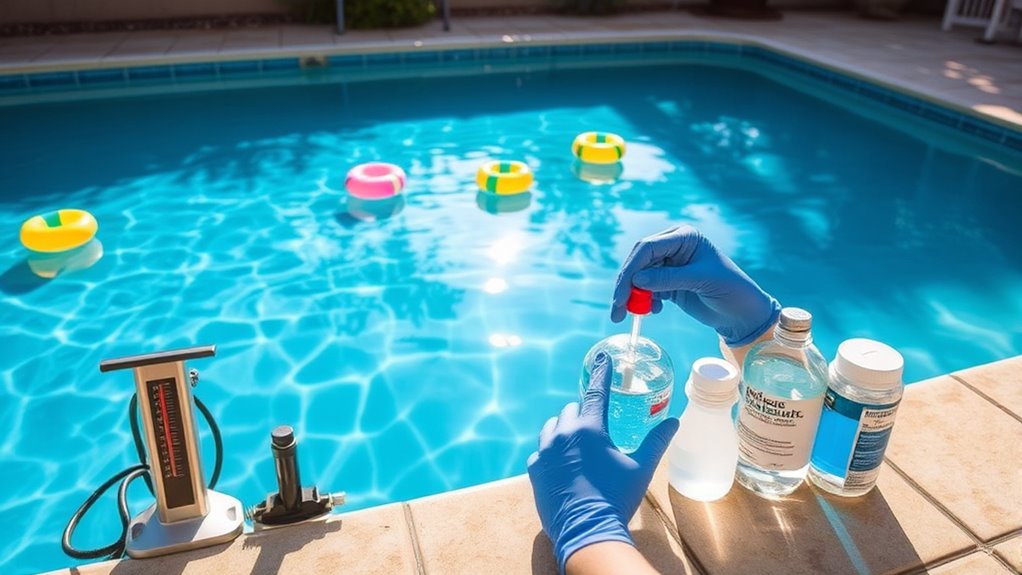
You need to regularly test your pool’s chemical levels after a party to identify any imbalances. Once you have the results, you can follow proper procedures to adjust chlorine, pH, alkalinity, and calcium hardness. Accurate monitoring and timely chemical adjustments guarantee your pool stays clean, safe, and balanced. Organic and chemical substances introduced during a party can alter pH and alkalinity levels, making it essential to check and correct these parameters to maintain water quality. Incorporating appropriate water testing methods ensures reliable results and helps prevent potential issues.
Testing and Monitoring
Effective testing and monitoring are essential to maintaining a healthy and balanced pool after a party. You need to check chemical levels every 2–3 days, especially after heavy use or storms. Use test strips, liquid kits, or digital testers for accurate readings of chlorine, pH, and alkalinity. For precise results, sample water at elbow depth, away from return jets, after circulation runs for an hour. Regularly test calcium hardness and cyanuric acid weekly to ensure stability. After a big event, test immediately to identify imbalances caused by debris or increased bather load. Proper monitoring helps you catch issues early, avoiding problems like cloudy water or equipment damage. Using accurate testing methods is crucial for maintaining water quality. Test at consistent times for reliable results. Follow kit instructions carefully. Record all test data systematically. Use fresh reagents and test strips. Adjust testing frequency after storms or heavy use, and consider chemical balance monitoring to maintain optimal water conditions.
Chemical Adjustment Procedures
Maintaining ideal chemical balance in your pool requires precise adjustments based on regular testing. To raise alkalinity, add sodium bicarbonate (baking soda) at 1.25 lb per 10,000 gallons for a 10 ppm increase. To lower alkalinity, use muriatic acid or pH decreaser, adding it slowly in a still area for maximum effect. Allow several hours of circulation before retesting. When adjusting pH, add soda ash to raise it or muriatic acid to lower it, always slowly and with protective gear. Remember, pH and alkalinity are interconnected, so adjustments may influence each other. Understanding chemical relationships is key to maintaining pool water balance. For calcium hardness, add calcium chloride to increase or partially drain and refill with softer water to decrease. Make all adjustments gradually, retesting after each to achieve the target levels and maintain a balanced, safe pool. Regular testing ensures that all chemical levels stay within their optimal ranges for safe and clear swimming conditions.
Monitoring Chlorine Demand Over the Following Days

Monitoring chlorine demand over the days following a pool party is essential to guarantee water quality and safety. Elevated chlorine demand can persist for days or weeks due to lingering organics like sweat, lotions, and dead skin, which consume sanitizer quickly. Regular testing helps you track how much chlorine is needed to maintain proper levels. You should test free and total chlorine daily for at least 48 hours, noting combined chlorine levels to identify chloramine buildup. If chlorine drops below 1–3 ppm, additional shocking is necessary. Using reliable test kits like FAS-DPD ensures accurate measurements. Continuous circulation and timely shock treatments prevent cloudy or oily water and reduce the risk of algae or bacteria growth. Monitoring closely keeps your pool safe and clean during recovery. Understanding chlorine demand can help you better anticipate how much sanitizer your pool needs after heavy use.
Ensuring Proper Filtration and System Maintenance
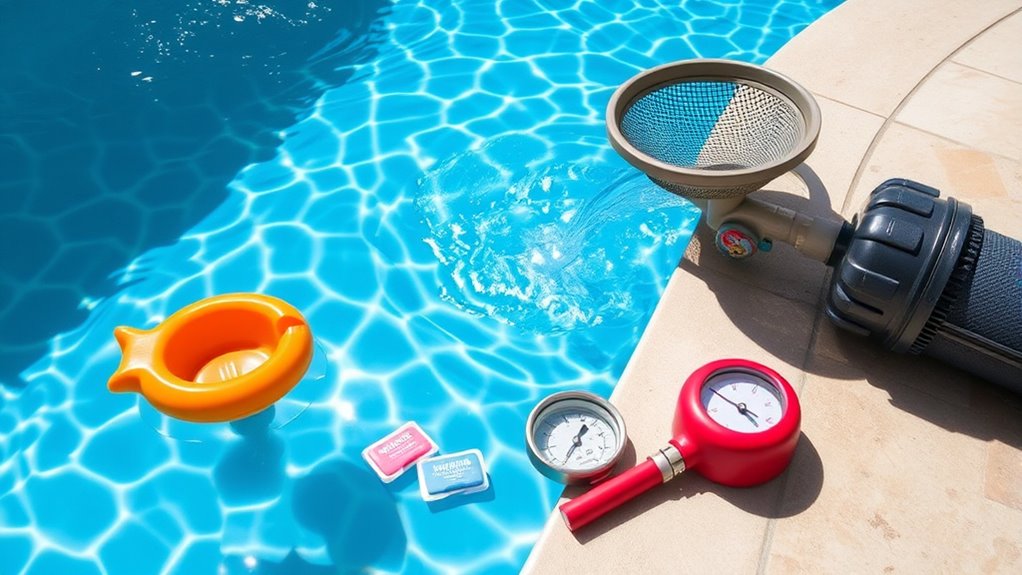
After a pool party, it’s crucial to promptly inspect and clean your filtration system to prevent clogs and guarantee proper water flow. Start by examining filters for debris buildup and pressure increases, which signal they need cleaning. Remove and hose down cartridge filters or backwash sand and D.E. filters as necessary. Keep an eye on the pressure gauge; a rise of about 10 PSI indicates it’s time to clean or replace filters. Ensure all equipment, like skimmers, pumps, and chemical feeders, are properly reinstalled and functioning. Regularly rinse filters during prolonged runs to maintain efficiency and prevent system overload. Also, check that skimmer and pump baskets are clear to keep water circulating smoothly, supporting overall system health and water clarity. Proper filter maintenance supports the overall longevity and efficiency of your pool system. Additionally, inspecting and maintaining filtration system components regularly can significantly reduce the risk of future issues.
Maintaining Water Circulation for Consistent Quality

To guarantee your pool stays clean and safe after a party, running the filtration system for at least 8 to 24 hours is essential. Continuous circulation helps evenly distribute chlorine and other sanitizers, ensuring all areas are protected. It also prevents debris and contaminants from settling, reducing the risk of bacterial growth and algae. Maintaining proper water levels at the skimmer halfway up ensures your pump operates efficiently, avoiding damage from low water. Regularly check and clean your pump and skimmer baskets to keep water flow ideal. Monitoring pressure gauges helps identify when backwashing is needed. Running the filter long enough to clarify the water maximizes sanitation and keeps your pool looking inviting. Proper circulation also supports maintaining optimal color accuracy, ensuring your pool’s appearance remains vibrant and inviting.
Implementing Preventative Measures for Future Gatherings
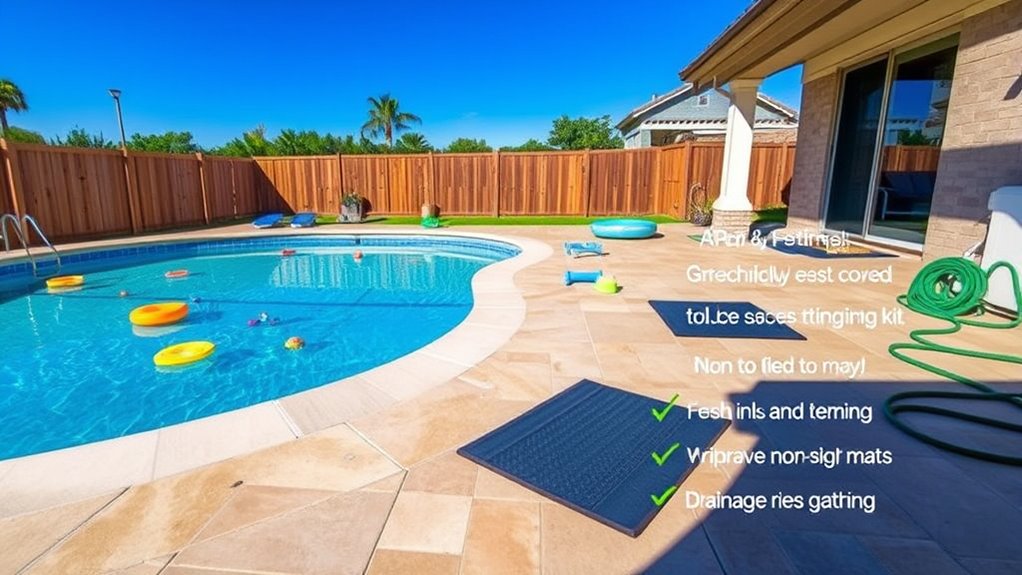
Implementing preventative measures before your gathering can considerably reduce pool maintenance and guarantee a safer, more enjoyable experience for your guests. You should test and balance pH, alkalinity, and sanitizer levels 24 hours in advance. Shock the pool the night before to ensure sufficient sanitizer reserves. Clean skimmer and pump baskets to improve filtration during high bather load. Top off water to the recommended level to compensate for splash loss. Adding enzymes helps break down non-living organics introduced by guests. Educate guests to shower beforehand, avoid lotions, and refrain from swimming with open wounds. Designate food zones away from the pool and provide outdoor showers or rinse stations. Assign someone to monitor contaminants and keep debris out of the water. Regularly inspecting your equipment ensures optimal performance and extends its lifespan.
Frequently Asked Questions
How Often Should I Test My Pool Water During the Days After a Party?
You should test your pool water at least twice daily during the first 24-48 hours after a party. If you notice heavy usage or water issues, increase testing to three times per day. Continue checking 2-3 times weekly until the water parameters stabilize. Use test strips or liquid kits for quick readings, and consider professional analysis every few weeks, especially after large gatherings.
What Are Signs of an Unbalanced Pool Water Chemistry?
You’ll notice signs of unbalanced pool water chemistry when the water looks cloudy or murky, or if there’s a strong chlorine smell caused by chloramines. You might also experience skin or eye irritation, or see algae growth and unusual coloration. These issues happen when pH, sanitizer, or calcium levels are off. Keep an eye out for these signs, and test your water regularly to keep everything balanced and safe for swimmers.
How Can I Prevent Algae Growth Post-Party?
You can prevent algae growth after a pool party by acting fast like a superhero! Test and adjust your sanitizer levels, keeping free chlorine between 1-4 ppm, and add algaecide to stop spores in their tracks. Skim debris, brush surfaces, and vacuum the pool to remove organic matter. Run your pump for at least 8-12 hours daily, and cover the pool when not in use to block sunlight and algae’s favorite fuel.
What Should I Do if Chlorine Levels Are Too High After Rebalancing?
If your chlorine levels are too high, stop adding chlorine immediately and use chemical neutralizers like sodium thiosulfate or hydrogen peroxide following the instructions. Retest the water after treatment to verify levels drop into the safe range (1–3 ppm). You can also expose the pool to sunlight to accelerate chlorine breakdown. If needed, consider partially draining and refilling the pool to dilute excess chlorine.
How Long Should I Run the Filter System After Cleaning and Shock Treatment?
You should run your filter system for at least 8 hours after cleaning and shock treatment, but for severe contamination, aim for 24 hours or more. Think of it as giving your pool a thorough sweep—continuous circulation guarantees even distribution of chemicals and clears out debris. Keep the pump running, monitor water clarity, and check chlorine levels before swimming, so your pool stays safe and sparkling.
Conclusion
After a pool party, it’s likely you’ll see elevated contaminants, so rebalancing your water is vital. Think of your pool’s chemistry like a delicate dance—if one step is off, the whole routine can falter. By promptly testing, shocking, and adjusting chemicals, you guarantee your water remains safe and inviting. This proactive approach not only restores balance but also supports the idea that consistent maintenance prevents bigger issues, keeping your pool crystal clear and ready for next time.

